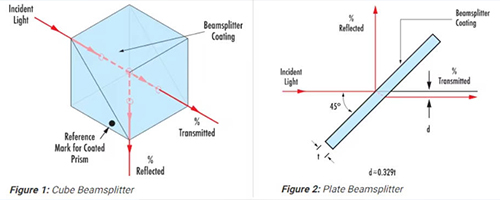ISO9001 Certified Professional Manufacturer & Supplier of Optics
+86-0431-87911611 admin@ytoptics.com
Contact us
-
 Email: admin@ytoptics.com
Email: admin@ytoptics.com
-
 Tel:86-0431-87911611
Tel:86-0431-87911611
-
 Add: 2# Automotive Innovation
Add: 2# Automotive Innovation
Jilin Province, China
Changchun Yutai Optics Co., Ltd.
Yutai Optics 一 Beamsplitter
Beamsplitter Prism is constructed by cementing two right angle prisms, Standard Cube Beamsplitters offer a range of reflection/transmission ratios. An interference coating has been applied to the hypotenuse surface of one of the prisms to provide the designated reflection/transmission ratio. Absorption loss to the coating is minimal.

The basic principle of optical beamsplitting prisms is rooted in the law of refraction of light. When a beam of light is incident on the surface of a prism, the direction of propagation of the light changes due to the difference in refractive index between the prism material and the surrounding medium. The subtlety of a beam-splitting prism is that it can break down composite light into different colors (i.e., different wavelengths) according to the differences in the refraction process of light of different wavelengths, as if splitting a colorful band of light into a single monochromatic filament.
Cube Beamsplitters Prism
*Designed for Common Diode, Gas, and Solid State Lasers
*Reflects S-Polarized Light, Transmits P-Polarized Light
*High Extinction Ratio
Designed for many common laser wavelengths, Laser Line Polarizing Cube Beamsplitters split randomly polarized beams into two orthogonal, linearly polarized components. S-polarized light is reflected at a 90° angle, while P-polarized light is transmitted. Each beamsplitter consists of a pair of precision right angle prisms cemented together to minimize transmitted wavefront distortion, and to provide excellent parallelism between incoming and transmitted beams.

Cube Beamsplitters Prism
*Designed for Common Diode, Gas, and Solid State Lasers
*Reflects S-Polarized Light, Transmits P-Polarized Light
*High Extinction Ratio
Designed for many common laser wavelengths, Laser Line Polarizing Cube Beamsplitters split randomly polarized beams into two orthogonal, linearly polarized components. S-polarized light is reflected at a 90° angle, while P-polarized light is transmitted. Each beamsplitter consists of a pair of precision right angle prisms cemented together to minimize transmitted wavefront distortion, and to provide excellent parallelism between incoming and transmitted beams.

Visible 400 to 700nm dichroic beamsplitter beam splitter glass for microscope
Beamsplitters are optical components used to split incident light at a designated ratio into two separate beams. Additionally, beamsplitters can be used in reverse to combine two different beams into a single one. Beamsplitters are often classified according to their construction: cube or plate. Yutai Optics supports your any standard or custom enquiry!

Beamsplitters are optical components used to split incident light at a designated ratio into two separate beams. Additionally, beamsplitters can be used in reverse to combine two different beams into a single one. Beamsplitters are often classified according to their construction: cube or plate. Yutai Optics supports your any standard or custom enquiry!

In the field of optical instruments, it is one of the core components of the spectrometer. The spectrometer breaks down the light with the help of spectroscopic prisms, and then detects and analyzes the light of different wavelengths with the help of detectors, so as to realize the qualitative and quantitative research on substances. In the field of photography, unique visual effects can be created by splitting and recombining light. In the field of optical communication, it can divide a beam of light into multiple beams of light according to a certain ratio, realizing the split transmission of optical signals and laying the foundation for high-speed and large-capacity optical communication networks.
Yutai Optics offers a wide range of spectral ratios, such as T:R=50:50/70:30/80:20/60:40, with most products designed for visible wavelengths, and other wavelengths can be customized. Yutai Optics can also customize Polarized Cube Beamsplitters (PBS) and Non-Polarized Cube Beamsplitters (NPBS). For polarized cube beamsplitters, we can now achieve an extinction ratio of 500:1. As coating technology improves, this value will likely be continually refreshed.
Yutai Optics offers a wide range of spectral ratios, such as T:R=50:50/70:30/80:20/60:40, with most products designed for visible wavelengths, and other wavelengths can be customized. Yutai Optics can also customize Polarized Cube Beamsplitters (PBS) and Non-Polarized Cube Beamsplitters (NPBS). For polarized cube beamsplitters, we can now achieve an extinction ratio of 500:1. As coating technology improves, this value will likely be continually refreshed.
PREV : Merry Christmas! NEXT : Happy Thanksgiving(November 28)

TALK TO US 86-0431-87911611
86-0431-87911611
Call us now!
 86-0431-87911611
86-0431-87911611Call us now!
ONLINE CHAT
 2433808388
2433808388

